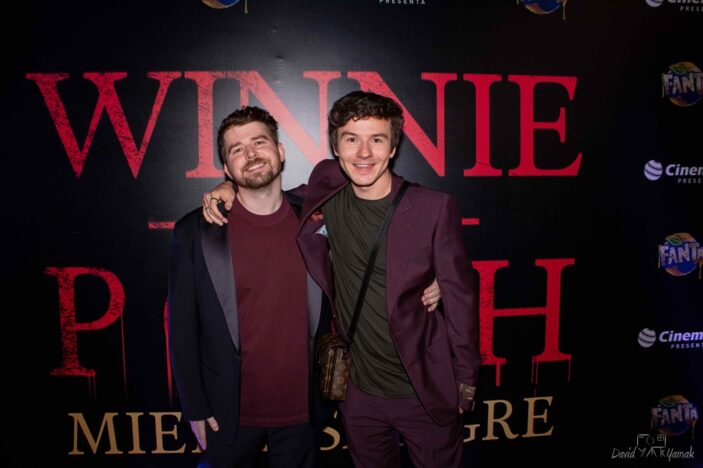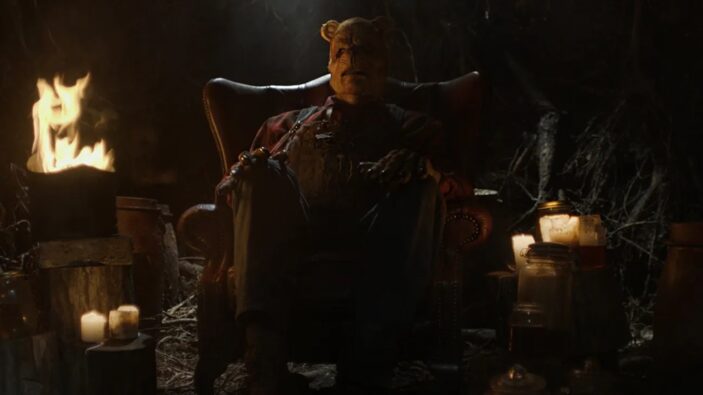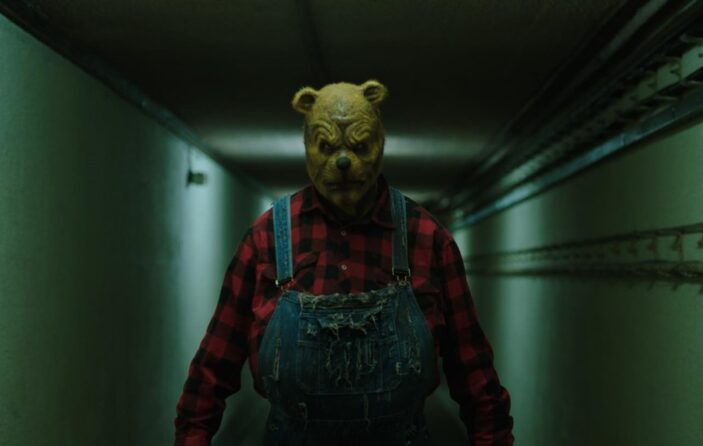
Whilst it was a film that saw a critical slaughtering at the time of its release – it currently holds a 3% rating on Rotten Tomatoes and is oft-considered now one of the worst films ever made – there’s no denying that Winnie-the-Pooh: Blood and Honey, a low budget horror recount of A.A. Milne’s classic creations, rode the wave of curiosity and controversy to its own benefit. With a $5.2 million dollar haul, it made 50 times its production budget, paving the way for a universe of horrific adaptations of some of literature’s most popular characters.
But before the recently dubbed “Poohniverse” assembles for all to see, director Rhys Frake-Waterfield and new Christopher Robin, Scott Chambers, are unleashing a second serving of blood and honey in the much-talked about sequel, Winnie-the-Pooh: Blood and Honey II.
Deep within the 100-Acre-Wood, a destructive rage grows as Winnie-the-Pooh, Piglet, Owl, and Tigger find their home and their lives endangered after Christopher Robin revealed their existence. Not wanting to live in the shadows any longer, the group decides to take the fight to the town of Ashdown, home of Christopher Robin, leaving a bloody trail of death and mayhem in their wake. Winnie and his savage friends will show everyone that they are deadlier, stronger, and smarter than anyone could ever imagine and get their revenge on Christopher Robin, once and for all.
As the film arrives in Australian theatres this week, Peter Gray spoke with the duo about navigating the first film’s divisive reaction, what we can expect from them going forward, and, of course, the joy of unleashing gore on screen.
Rhys, congratulations on the success of the original film. Were you expecting that reaction?
Rhys Frake-Waterfield: In terms of the scale, when it was made we had a conveyor belt of projects going at the time. It was still quite early in my career, and I was just going full steam ahead. I thought (Winnie-the-Pooh: Blood and Honey) was a good idea, so I wanted to direct it and make it as good as possible. And then it blew up and went absolutely mad. I remember thinking, “Oh, shit, everyone’s going to see this film now!” It was made on very, very little money. Like, the first one was only (about) $20,000. Obviously, it was a hugely commercially successful (film), which was amazing, and then that opened the doors to a sequel with a significantly higher budget. That kind of led me to essentially start again and think, “Okay, what if now I’ve got more time and more resources? What do I actually want to do with this concept?” Hence why there’s been so many changes.
And Scott, coming into this one as Christopher Robin, what was your approach?
Scott Chambers: Yeah, so I produced the first film with Rhys. I was very much along that journey with him. When he said to me that he was going to redo (the story), well start again, basically, and that he was going to make the first film a film within (this) movie, and he was recasting, I thought it was cool. He asked me if I wanted to (play) Christopher Robin, because he’s been there along with my acting career with me, and he’s always been supportive. I was a bit intimidated to play Christopher Robin, just because of the mixed reception the first (film) got. And I do feel bad for those involved, because I don’t think anyone was expecting that to happen. They all thought it was going to go on Amazon Prime, or something, and then it blew up and everyone’s getting judged in so many ways.
I think I was mostly intimidated, because (even) if you try hard, it doesn’t matter. I feel like being an actor, the face of Christopher Robin in Winnie-the-Pooh as a horror, people are going to want to drag you down and say nasty things. I think that is something that I was really nervous about. You’ve got to have a thick skin. With my acting, I’ve never experienced this, and I didn’t know how I was going to handle it. I didn’t take note of what the performer in the first film did (Nikolai Leon). I just did my own thing. I kind of thought, you know, (Christopher Robin) starts in this place where the massacre happened to him a year ago, and how would you play a character that’s still likeable? He’s in so much of the movie, and you don’t want to see someone that’s just constantly down and out having a mental breakdown. We want to give him hope. Let him smile wherever possible, and just try and bring the vulnerability and truth to it, really.
I’m a horror fan, and I’ve been fortunate to speak to a lot of actors and filmmakers of the genre, and I always love knowing what the gateway movie into the genre was for them. So, for the both of you, which horror movie was the one that got you interested in horror?
Scott Chambers: So mine is definitely Scream, without a doubt. When I was 6-years-old, my sister was babysitting me and she put it on. She would cover my eyes every time someone died (laughs). You know, when Rose McGowan gets her head squashed in the garage, they were like, “She jumped down and she ran off into the woods.” For my 7th birthday, and I had been going on about how much I liked (Scream), my brother bought me the video of it. I went upstairs and played it that night, and I watched it on my own, and I’m actually seeing Drew Barrymore getting stabbed, and Rose actually getting her head crushed, and I was so scared! I couldn’t sleep that night, and my mum told my brother to go into my room and explain what film is. And that’s when I wanted to become a filmmaker.
Rhys Frake-Waterfield: I would probably say either (Child’s Play) or Texas Chainsaw Massacre, but the 2003 one. I remember when I was a kid they were the ones that we would put on. I love them both, but for different reasons. With The Texas Chainsaw Massacre, I actually didn’t like the 1974 one. For me, as a kid, I was like, “It’s too old.” (Laughs). But I found (Leatherface) really scary, and I honestly thought it was real. Like, they marketed it as being based on a true story. I thought, even in the UK, that he was going to be sitting next to me on a plane or something (laughs). And with Chucky, I have this love for the horror comedy side of it, and as a kid I gravitated towards that.

The first round of kills in this movie is INSANE! The practical effects used in watching these poor characters…it’s horrific. But, as someone who loves gore, it was great. And then there’s the rave massacre further on in the film. Is Matt Leslie (the writer) presenting these scenarios to you? Or is there a lot of collaboration as to how they’re going to come about? I’m always fascinated by knowing where these elaborate death scenes originate from.
Rhys Frake-Waterfield: I would say, in terms of death scenes, Scott and I love the slashers. It’s the horror we gravitate towards. So we’re thinking a lot about these kills. So those girls getting absolutely massacred, we were just sitting and thinking about how they can be brutalised. And I just thought there’s some really weird imagery here about being on the floor, all her arms and legs broken, and a bear trap…but there’s something fun about it. It’s meant to be self aware, ultimately. Before you go into that scene, you have Simon Callow’s narration (mentioning) there’ll be casualties along the way, and then BOOM, you’re there.
The idea is that it’s almost bridging a gap between the first film and the second. In the first film, that is basically what happened. It was a bunch of girls who got obliterated, right? We thought it would be fun to make people think we’re going to do something like the first film, and then within 3 minutes, they’re all wiped out, and the main story begins. The deaths are still fun, but they’re more sinister and a bit scarier.
In terms of how we worked with Matt, he loves going into the story and that’s what we mostly fleshed out with him. Then we kind of said at the start with him, “Don’t worry about the death scenes because we’re working on a limited budget.” What happens on a lot of these budgets is you kind of improv stuff on the day. You get to a location, and this is what happened with Tigger, you start looking around at what you have. You’ve got to kill five (characters) in this place in the next 12 hours, so you start thinking of what sort of scenes you can do. For example, in the teaser that announced the film, the girl has her eyes plucked out and she’s crawling…that was all just improv’d on the day. Then the other girl who’s dancing on the grates and the blood is dripping down, that was also improv’d because we that the grates were just big enough for fingers to fit through. A lot of it was done on the fly.
Others were pre-planned out, like the dishwasher scene, because that was necessary to get the really good type of practical effects there. In order to make sure they worked out well, we got a really good company on board called The Pacific Studio, and they’ve worked on Voldemort (Harry Potter) and the Red Skull from Captain America. They’ve done big stuff. My personal favourite is (the character of) Aaron, and his face is blown off. They try and repair it but they do a terrible job. It’s meant to be over the top and a bit dramatic. I love that moment when he turns and he’s an absolute mess.
Do you have a favourite kill in the movie, Scott?
Scott Chambers: It’s so hard, because I’ve got three that stick out. The girl with the limbs and the bear trap. I just think that’s savage. It just goes on and on. This poor fucking girl. (Pooh’s) so ruthless. I’d say her and the dishwasher (scene). I was basically developing a Steamboat Willie film last year that I ended up pulling away from. We said we weren’t going to do it in the end. When you look into the legalities of it, it was not quite what you think. But I had this idea of a dishwasher and the knives pointing out, and Mickey Mouse pushing someone’s head on it. Then he starts eating his cheese as (they’re) dying. I had that idea, and I’m so glad I told (Rhys). He went above and beyond to make it not just one knife, but a whole load of cutlery. I think that one just because it’s so disgusting. And I always had this fear because I used to live with a housemate and they used to put the knives in upside down. I was like, “What if I tripped and fell on that?”
And then the final (death), just because it’s so fun. It’s a great one, the one Rhys is talking about. So, it’s Tigger and there’s a girl, and we see the grates. I asked Rhys if he had seen House of Wax? Paris Hilton has her foot in the grate and gets stabbed. And because I was doing costumes on the film, I put the dog collar on the actress and I was like, “What if the dog collar falls over the balcony?” And Rhys was like, “Yeah! And he grabs it and holds it in place and then stabs the crap out of her!”
Rhys Frake-Waterfield: Off the first film, I had a lot of fun deaths there, but I had people saying that I was misogynistic. That I hated women. But it’s like, people don’t know that I’m LGBT. So, to me, it was just fun. It was coming from a positive, fun place. And that’s the same with all of these, even though a lot of the times horror films just like to have female victims. Like, they have a lot of girls in it. It’s just a trope. A lot of girls have these horrible things happen to them (in the film), but the (actresses) all show up and are laughing on set. We’re all having a good time.

You mentioned the legalities before. When these stories are out there in public domain, do you have to wait until it’s official to even start planning anything?
Rhys Frake-Waterfield: There’s a really tricky line with all of this, because some people have tried…I don’t know if you’ve seen it, but Mousetrap was banned. We’ve heard from people that they are unable to get insurance at this point. You need to get the insurance to get the film released. And we’ve heard it’s basically impossible. And the reason for that is it’s super dodgy ground. It was really difficult to even get Winnie. So just because something falls into the public domain, doesn’t mean it’s an easy ride to quickly get it through. It can be really, really hard. And we don’t actually want to do that.
The reason we didn’t go for Steamboat Willie in the end is partly because we felt like something was happening legally, but we thought there was going to be a big rat race coming towards it. That loads of people are going to do it. And I think there’s like four (companies) doing it now. So we’re about to flooded with that. There’s been Alice in Terrorland. There’s been Goldilocks and the Three Bears. It’s all getting flooded. Everyone is trying to bash these out as quickly as they can, but we’re trying to take a bit of a different strategy with it. We don’t want to be taking every single IP we possibly can. We want to look at the ones which we selectively think will make a good horror film, and make sure the quality is there for it.
Personally, I think (this film) is a huge step up in areas relative to what people want. And if people like it, and it’s well received, then we’re only going to keep going with that approach. Winnie 3, the budget will go up even more. We’ll get more creative. We’ll make it even bigger. But that only happens when people support (us). We’re not going down the cash-grabby route. If we wanted to, we could have done everything by now. We could have had every IP out there possible. But I don’t think that’s the best approach for long term success.
And we now have the “Poohniverse: Monsters Assemble” on the way. Is there one particular title or character in there that you’re most excited for the people to see in all their horrific, disgusting glory?
Rhys Frake-Waterfield: So, we’ve got three films, all of which are by different directors. I’ve been focusing on Winnie. Scott’s doing Peter Pan. And our friend, who’s a bit of an up-and-coming British director, is focusing on Bambi. After those are done, there’s one character we’re going to be focusing on: Pinocchio. We’ve been in talks with Todd Masters to design the doll, and his company made Chucky, so you can see the kind of direction that’s going. I think there’s a lot of fun to be had with Pinocchio.
Scott, can you drop anything about Peter Pan? Or is it all hush hush at this point?
Scott Chambers: I can, yeah. Peter Pan is going to, tonally, be really, really dark. One of my favourite films, in a really twisted way, is Hounds of Love from Australia. That’s actually one of my main (inspirations). It’s like the biggest hint as to where I’m going with Peter Pan and Tinkerbell. I’m a lot more excited by characters and manipulation. All that kind of stuff in horror is really important to play into suspense. If someone is desperate, it’s horrible, because you think what are they willing to do for you? So it’s a mix between Hounds of Love and a film called Switchblade Romance, which is also known as High Tension. That’s one of my favourites. That and then a little bit of The Black Phone. I’d say it’s a mix of those three together. Essentially, the plot is Wendy’s little brother is abducted, and she has to basically find him, but I want it to be intense. Wendy is going to go through it!
Winnie-the-Pooh: Blood and Honey II is screening in Australian theatres for a special event long weekend from March 28th to April 1st, 2024.
